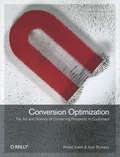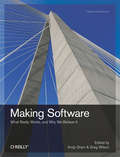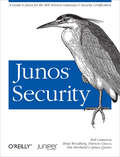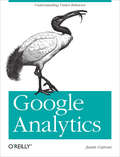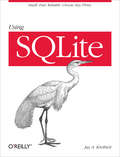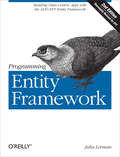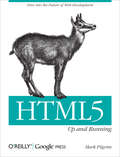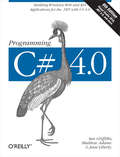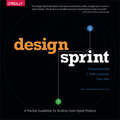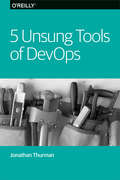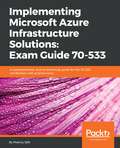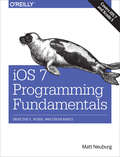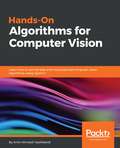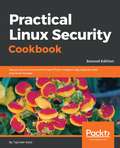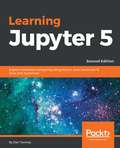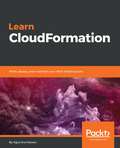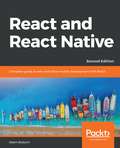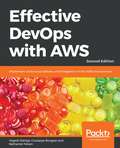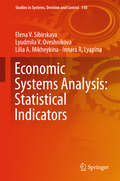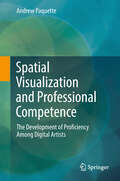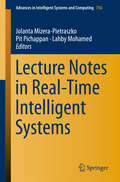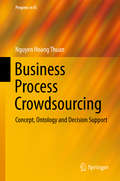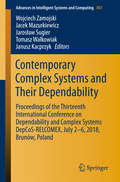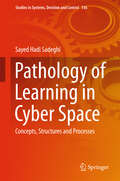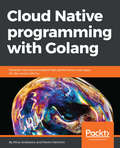- Table View
- List View
Conversion Optimization: The Art and Science of Converting Prospects to Customers
by Khalid Saleh Ayat ShukairyHow do you turn website visitors into customers? Conversion Optimization offers practical advice on how to persuade visitors to make a buying decision -- without driving them away through data overload or tedious navigation. You'll learn how to use marketing principles, design, usability, and analytics on your site to increase your buyer-to-visitor ratio, whether you're involved with marketing or designing a large ecommerce site, or managing a modest online operation. Based on the authors' broad experience in helping businesses attract online customers, this book addresses every aspect of the process, from landing visitors to finalizing the sale. You'll learn several techniques for blending successful sales approaches with the particular needs of the people you want to attract. Are you ready to do what it takes to get a double-digit conversion rate? Explore case studies involving significant conversion rate improvements Walk through different stages of a sale and understand the value of each Understand your website visitors through persona creation Connect with potential customers and guide them toward a conversion Learn how to deal with FUDs -- customer fears, uncertainties, and doubts Examine the path that visitors take from landing page to checkout Test any change you make against your original design "The Web is unique in its ability to deliver this almost improbable win-win: You can increase revenue AND make your customers happy. Yet most websites stink. Worry not, Khalid and Ayat to the rescue! Buy this book to follow their practical advice on how to create high converting websites that your visitors love." --Avinash Kaushik, author of Web Analytics 2.0 and Web Analytics: An Hour A Day (both Sybex)
Making Software: What Really Works, and Why We Believe It (O'reilly Ser.)
by Greg Wilson Andy OramMany claims are made about how certain tools, technologies, and practices improve software development. But which claims are verifiable, and which are merely wishful thinking? In this book, leading thinkers such as Steve McConnell, Barry Boehm, and Barbara Kitchenham offer essays that uncover the truth and unmask myths commonly held among the software development community. Their insights may surprise you. Are some programmers really ten times more productive than others? Does writing tests first help you develop better code faster? Can code metrics predict the number of bugs in a piece of software? Do design patterns actually make better software? What effect does personality have on pair programming? What matters more: how far apart people are geographically, or how far apart they are in the org chart? Contributors include: Jorge Aranda Tom Ball Victor R. Basili Andrew Begel Christian Bird Barry Boehm Marcelo Cataldo Steven Clarke Jason Cohen Robert DeLine Madeline Diep Hakan Erdogmus Michael Godfrey Mark Guzdial Jo E. Hannay Ahmed E. Hassan Israel Herraiz Kim Sebastian Herzig Cory Kapser Barbara Kitchenham Andrew Ko Lucas Layman Steve McConnell Tim Menzies Gail Murphy Nachi Nagappan Thomas J. Ostrand Dewayne Perry Marian Petre Lutz Prechelt Rahul Premraj Forrest Shull Beth Simon Diomidis Spinellis Neil Thomas Walter Tichy Burak Turhan Elaine J. Weyuker Michele A. Whitecraft Laurie Williams Wendy M. Williams Andreas Zeller Thomas Zimmermann
Junos Security: A Guide to Junos for the SRX Services Gateways and Security Certification
by Patricio Giecco Timothy Eberhard Rob Cameron James Quinn Brad WoodbergJunos® Security is the complete and authorized introduction to the new Juniper Networks SRX hardware series. This book not only provides a practical, hands-on field guide to deploying, configuring, and operating SRX, it also serves as a reference to help you prepare for any of the Junos Security Certification examinations offered by Juniper Networks. Network administrators and security professionals will learn how to use SRX Junos services gateways to address an array of enterprise data network requirements -- including IP routing, intrusion detection, attack mitigation, unified threat management, and WAN acceleration. Junos Security is a clear and detailed roadmap to the SRX product lines. Get up to speed on Juniper's multi-function SRX platforms and SRX Junos software Explore case studies and troubleshooting tips from engineers with extensive SRX experience Become familiar with SRX security policy, Network Address Translation, and IPSec VPN configuration Learn about routing fundamentals and high availability with SRX platforms Discover what sets SRX apart from typical firewalls Understand the operating system that spans the entire Juniper Networks networking hardware portfolio Learn about the more commonly deployed branch series SRX as well as the large Data Center SRX firewalls "I know these authors well. They are out there in the field applying the SRX's industry-leading network security to real world customers everyday. You could not learn from a more talented team of security engineers." --Mark Bauhaus, EVP and General Manager, Juniper Networks
Google Analytics: Understanding Visitor Behavior
by Justin CutroniDo you know what people do when they visit your website or web app? Or how much the site contributes to your bottom line? Google Analytics keeps track and makes it easy for you to learn precisely what's happening. This hands-on guide shows you how to get the most out of this free and powerful tool -- whether you're new to Google Analytics or have been using it for years. Google Analytics shows you how to track different market segments and analyze conversion rates, and reveals advanced techniques such as marketing-campaign tracking, a valuable feature that most people overlook. And this practical book not only provides complete code samples for web developers, it also explains the concepts behind the code to marketers, managers, and others on your team. Discover exactly how the Google Analytics system works Learn how to configure the system to measure data most relevant to your business goals Track online marketing activities, including cost-per-click ads, email, and internal campaigns Track events -- rather than page views -- on sites with features such as maps, embedded video, and widgets Configure Google Analytics to track enterprise data, including multiple domains Use advanced techniques such as custom variables and CRM integration
Using SQLite: Small. Fast. Reliable. Choose Any Three. (O'reilly Ser.)
by Jay A. KreibichApplication developers, take note: databases aren't just for the IS group any more. You can build database-backed applications for the desktop, Web, embedded systems, or operating systems without linking to heavy-duty client-server databases such as Oracle and MySQL. This book shows you how to use SQLite, a small and lightweight relational database engine that you can build directly into your application. With SQLite, you'll discover how to develop a database-backed application that remains manageable in size and complexity. This book guides you every step of the way. You'll get a crash course in data modeling, become familiar with SQLite's dialect of the SQL database language, and much more. Learn how to maintain localized storage in a single file that requires no configuration Build your own SQLite library or use a precompiled distribution in your application Get a primer on SQL, and learn how to use several language functions and extensions Work with SQLite using a scripting language or a C-based language such as C# or Objective-C Understand the basics of database design, and learn how to transfer what you already know to SQLite Take advantage of virtual tables and modules "Complex SQL concepts explained clearly." --D. Richard Hipp, creator of SQLite
Programming Entity Framework: Building Data Centric Apps with the ADO.NET Entity Framework (Oreilly And Associate Ser.)
by Julia LermanGet a thorough introduction to ADO.NET Entity Framework 4 -- Microsoft's core framework for modeling and interacting with data in .NET applications. The second edition of this acclaimed guide provides a hands-on tour of the framework latest version in Visual Studio 2010 and .NET Framework 4. Not only will you learn how to use EF4 in a variety of applications, you'll also gain a deep understanding of its architecture and APIs. Written by Julia Lerman, the leading independent authority on the framework, Programming Entity Framework covers it all -- from the Entity Data Model and Object Services to WCF Services, MVC Apps, and unit testing. This book highlights important changes for experienced developers familiar with the earlier version. Understand the core concepts you need to make the best use of the EF4 in your applications Learn to query your data, using either LINQ to Entities or Entity SQL Create Windows Forms, WPF, ASP.NET Web Forms, and ASP.NET MVC applications Build and consume WCF Services, WCF Data Services, and WCF RIA Services Use Object Services to work directly with your entity objects Create persistent ignorant entities, repositories, and write unit tests Delve into model customization, relationship management, change tracking, data concurrency, and more Get scores of reusable examples -- written in C# (with notes on Visual Basic syntax) -- that you can implement right away
HTML5: Dive into the Future of Web Development
by Mark PilgrimIf you don't know about the new features available in HTML5, now's the time to find out. This book provides practical information about how and why the latest version of this markup language will significantly change the way you develop for the Web. HTML5 is still evolving, yet browsers such as Safari, Mozilla, Opera, and Chrome already support many of its features -- and mobile browsers are even farther ahead. HTML5: Up & Running carefully guides you though the important changes in this version with lots of hands-on examples, including markup, graphics, and screenshots. You'll learn how to use HTML5 markup to add video, offline capabilities, and more -- and you'll be able to put that functionality to work right away. Learn new semantic elements, such as , , and Meet Canvas, a 2D drawing surface you can program with JavaScript Embed video in your web pages without third-party plugins Use Geolocation to let web application visitors share their physical location Take advantage of local storage capacity that goes way beyond cookies Build offline web applications that work after network access is disconnected Learn about several new input types for web forms Create your own custom vocabularies in HTML5 with microdata
Programming C# 4.0: Building Windows, Web, and RIA Applications for the .NET 4.0 Framework (Animal Guide)
by Matthew Adams Jesse Liberty Ian GriffithsWith its support for dynamic programming, C# 4.0 continues to evolve as a versatile language on its own. But when C# is used with .NET Framework 4, the combination is incredibly powerful. This bestselling tutorial shows you how to build web, desktop, and rich Internet applications using C# 4.0 with .NET's database capabilities, UI framework (WPF), extensive communication services (WCF), and more. In this sixth edition, .NET experts Ian Griffiths, Matthew Adams, and Jesse Liberty cover the latest enhancements to C#, as well as the fundamentals of both the language and framework. You'll learn concurrent programming with C# 4.0, and how to use .NET tools such as the Entity Framework for easier data access, and the Silverlight platform for browser-based RIA development. Learn C# fundamentals, such as variables, flow control, loops, and methods Build complex programs with object-oriented and functional programming techniques Process large collections of data with the native query features in LINQ Communicate across networks with Windows Communication Foundation (WCF) Learn the advantages of C# 4.0's dynamic language features Build interactive Windows applications with Windows Presentation Foundation (WPF) Create rich web applications with Silverlight and ASP.NET
Design Sprint: A Practical Guidebook for Building Great Digital Products
by Trace Wax C. Todd Lombardo Richard BanfieldWith more than 500 new apps entering the market every day, what does it take to build a successful digital product? You can greatly reduce your risk of failure with design sprints, a process that enables your team to prototype and test a digital product idea within a week. This practical guide shows you exactly what a design sprint involves and how you can incorporate the process into your organization.Design sprints not only let you test digital product ideas before you pour too many resources into a project, they also help everyone get on board--whether they're team members, decision makers, or potential users. You'll know within days whether a particular product idea is worth pursuing.Design sprints enable you to:Clarify the problem at hand, and identify the needs of potential usersExplore solutions through brainstorming and sketching exercisesDistill your ideas into one or two solutions that you can testPrototype your solution and bring it to lifeTest the prototype with people who would use it
5 Unsung Tools of DevOps
by Jonathan ThurmanThe tools we use play a critical role in how effective we are. In today's ever-changing world of technology, we tend to focus on the latest and greatest solutions and overlook the simple tools that are available. Constant improvement of tools is an important aspect of the DevOps movement, but improvement doesn't always warrant replacement. The tools presented in 5 Unsung Tools of DevOps provide insight into or control over a DevOps environment--and they require minimal installation and configuration. They're not the flashiest tools, but they're time tested and just work.
Implementing Microsoft Azure Infrastructure Solutions: A comprehensive, end-to-end study guide for the 70-533 certification with practice tests
by Melony QinDevelop skills and knowledge for provisioning and managing services in Microsoft Azure and implement infrastructure componentsKey FeaturesBuild and manage robust infrastructure solutions on Microsoft AzurePlan and implement Azure storage, backup, and recovery servicesPrepare and boost your confidence with certification-based mock tests and solutionsBook DescriptionMicrosoft Azure is a prominent public cloud provider, recording the highest user base growth in the year 2017. Microsoft has prominent certifications that help architects, developers, and administrators gain hands-on knowledge while working on Azure. 70-533 is one such advanced-level certification, which deals with infrastructure solutions on Microsoft Azure.Implementing Microsoft Azure Infrastructure Solutions starts with an overview of the certification and an introduction to Microsoft Azure. Next, you will learn how to plan and implement virtual machines and containers, followed by designing and implementing service apps. As you make your way through the chapters, you will learn how to implement and manage virtual networks and Azure identities, as well as the Active Directory infrastructure in a hybrid environment. In the concluding chapters, you will learn how to plan and implement storage and security, and business continuity and disaster recovery (BCDR) strategies. You will also automate and monitor cloud management operations in Azure. By the end of the book, you will have covered all of the modules, along with the practice questions at the end of each chapter, which will be extremely helpful in passing the 70-533 certification exam.What you will learnExplore cloud basics and gain an overview of Microsoft AzurePlan and implement virtual machines and containers for scalability and resilienceUnderstand virtual networks' cross-premises connectivityLearn how to manage your Azure identitiesPlan and implement storage, security, and the BCDR strategyAutomate and monitor cloud management operations in AzureManage app services for resilience and availabilityInteracting with Azure Services by using ARM, the Azure CLI, and PowerShellWho this book is forImplementing Microsoft Azure Infrastructure Solutions is for senior cloud professionals who already have experience working with the Azure ecosystem and want to take their knowledge to the next level. Prior knowledge of the Azure ecosystem is necessary.
iOS 7 Programming Fundamentals: Objective-C, Xcode, and Cocoa Basics
by Matt NeuburgIf you're getting started with iOS development, or want a firmer grasp of the basics, this practical guide provides a clear view of its fundamental building blocks--Objective-C, Xcode, and Cocoa Touch. You'll learn object-oriented concepts, understand how to use Apple's development tools, and discover how Cocoa provides the underlying functionality iOS apps need to have. Dozens of example projects are available at GitHub. Once you master the fundamentals, you'll be ready to tackle the details of iOS app development with author Matt Neuburg's companion guide, Programming iOS 7--coming in December 2013. Explore the C language to learn how Objective-C works Learn how instances are created, and why they're so important Tour the lifecycle of an Xcode project, from inception to App Store Discover how to build interfaces with nibs and the nib editor Explore Cocoa's use of Objective-C linguistic features Use Cocoa's event-driven model and major design patterns Learn the role of accessors, key-value coding, and properties Understand the power of ARC-based object memory management Send messages and data between Cocoa objects
Hands-On Algorithms for Computer Vision: Learn how to use the best and most practical computer vision algorithms using OpenCV
by Amin Ahmadi TazehkandiCreate powerful, accurate, and real-time Computer Vision applications using a perfect blend of algorithms and filters. Also learn about object tracking and foreground extractions with a variety of new filters and algorithms.Key Features Filter, transform, and manipulate images using MAT class and OpenCV Framework Explore motion detection and object tracking with filters and algorithms Build object detectors using deep learning and machine learning algorithmsBook DescriptionAn arena that has been positively impacted by the advancements in processing power and performance is the field of computer vision. It's only natural that over time, more and more algorithms are introduced to perform computer vision tasks more efficiently. Hands-On Algorithms for Computer Vision is a starting point for anyone who is interested in the field of computer vision and wants to explore the most practical algorithms used by professional computer vision developers. The book starts with the basics and builds up over the course of the chapters with hands-on examples for each algorithm.Right from the start, you will learn about the required tools for computer vision development, and how to install and configure them. You'll explore the OpenCV framework and its powerful collection of libraries and functions. Starting from the most simple image modifications, filtering, and transformations, you will gradually build up your knowledge of various algorithms until you are able to perform much more sophisticated tasks, such as real-time object detection using deep learning algorithms.What you will learn Get to grips with machine learning and artificial intelligence algorithms Read, write, and process images and videos Perform mathematical, matrix, and other types of image data operations Create and use histograms from back-projection images Detect motion, extract foregrounds, and track objects Extract key points with a collection of feature detector algorithms Develop cascade classifiers and use them, and train and test classifiers Employ TensorFlow object detection to detect multiple objectsWho this book is forHands-On Algorithms for Computer Vision helps those who want to learn algorithms in Computer Vision to create and customize their applications. This book will also help existing Computer Vision developers customize their applications. A basic understanding of computer vision and programming experience is needed.
Practical Linux Security Cookbook: Secure your Linux environment from modern-day attacks with practical recipes, 2nd Edition
by Tajinder KalsiEnhance file system security and learn about network attack, security tools and different versions of Linux build.Key FeaturesHands-on recipes to create and administer a secure Linux systemEnhance file system security and local and remote user authenticationUse various security tools and different versions of Linux for different tasksBook DescriptionOver the last few years, system security has gained a lot of momentum and software professionals are focusing heavily on it. Linux is often treated as a highly secure operating system. However, the reality is that Linux has its share of security flaws, and these security flaws allow attackers to get into your system and modify or even destroy your important data. But there’s no need to panic, since there are various mechanisms by which these flaws can be removed, and this book will help you learn about different types of Linux security to create a more secure Linux system. With a step-by-step recipe approach, the book starts by introducing you to various threats to Linux systems. Then, this book will walk you through customizing the Linux kernel and securing local files. Next, you will move on to managing user authentication both locally and remotely and mitigating network attacks. Later, you will learn about application security and kernel vulnerabilities. You will also learn about patching Bash vulnerability, packet filtering, handling incidents, and monitoring system logs. Finally, you will learn about auditing using system services and performing vulnerability scanning on Linux.By the end of this book, you will be able to secure your Linux systems and create a robust environment.What you will learnLearn about vulnerabilities and exploits in relation to Linux systemsConfigure and build a secure kernel and test itLearn about file permissions and how to securely modify filesAuthenticate users remotely and securely copy files on remote systemsReview different network security methods and toolsPerform vulnerability scanning on Linux machines using toolsLearn about malware scanning and read through logsWho this book is forThis book is intended for all those Linux users who already have knowledge of Linux file systems and administration. You should be familiar with basic Linux commands. Understanding information security and its risks to a Linux system is also helpful in understanding the recipes more easily.
Learning Jupyter 5: Explore interactive computing using Python, Java, JavaScript, R, Julia, and JupyterLab, 2nd Edition
by Dan ToomeyCreate and share livecode, equations, visualizations, and explanatory text, in both a single document and a web browser with JupyterKey FeaturesLearn how to use Jupyter 5.x features such as cell tagging and attractive table stylesLeverage big data tools and datasets with different Python packagesExplore multiple-user Jupyter Notebook serversBook DescriptionThe Jupyter Notebook allows you to create and share documents that contain live code, equations, visualizations, and explanatory text. The Jupyter Notebook system is extensively used in domains such as data cleaning and transformation, numerical simulation, statistical modeling, and machine learning. Learning Jupyter 5 will help you get to grips with interactive computing using real-world examples.The book starts with a detailed overview of the Jupyter Notebook system and its installation in different environments. Next, you will learn to integrate the Jupyter system with different programming languages such as R, Python, Java, JavaScript, and Julia, and explore various versions and packages that are compatible with the Notebook system. Moving ahead, you will master interactive widgets and namespaces and work with Jupyter in a multi-user mode.By the end of this book, you will have used Jupyter with a big dataset and be able to apply all the functionalities you’ve explored throughout the book. You will also have learned all about the Jupyter Notebook and be able to start performing data transformation, numerical simulation, and data visualization.What you will learnInstall and run the Jupyter Notebook system on your machineImplement programming languages such as R, Python, Julia, and JavaScript with the Jupyter NotebookUse interactive widgets to manipulate and visualize data in real timeStart sharing your Notebook with colleaguesInvite your colleagues to work with you on the same NotebookOrganize your Notebook using Jupyter namespacesAccess big data in Jupyter for dealing with large datasets using SparkWho this book is forLearning Jupyter 5 is for developers, data scientists, machine learning users, and anyone working on data analysis or data science projects across different teams. Data science professionals will also find this book useful for performing technical and scientific computing collaboratively.
Learn CloudFormation: Write, deploy, and maintain your AWS infrastructure
by Agus KurniawanGet up and running with AWS automation using CloudFormationKey FeaturesExplore the fundamentals of AWS CloudFormationGet acquainted with concepts such as CloudFormation templates and mappingsLearn to implement Infrastructure as a Code (IaC) on AWSBook DescriptionAs the Amazon Web Services (AWS) infrastructure is gradually moving towards cloud, managing cloud-related tasks efficiently continues to be a challenge for system administrators. CloudFormation is a language developed for managing infrastructure-related services efficiently on AWS and its features help secure the AWS resource deployment process.Learn CloudFormation serves as a fundamental guide to kick-start your journey on CloudFormation. We will introduce you to the basic concepts on IaC and the AWS services required for implementing automation and infrastructure management. Then, we deep dive into concepts such as CloudFormation mapping, conditions, limit, and output and EC2. In the concluding chapters, you will manage the entire AWS infrastructure using CloudFormation templates.By the end of this book, you will get up and running with IaC with CloudFormation.What you will learnUnderstand AWS CloudFormationDevelop AWS CloudFormation templatesDeploy AWS CloudFormation for AWS resourcesBuild your first AWS CloudFormation projectExplore AWS Security featuresDeploy testing and production stages using CloudFormationWho this book is forLearn CloudFormation is for cloud engineers, system administrators, cloud architects, or any stakeholders working in the field of cloud development or cloud administration. Basic knowledge of AWS is necessary.
React and React Native: Complete guide to web and native mobile development with React, 2nd Edition
by Adam BoduchBuild applications for web and native mobile platforms with React, JSX, Redux, and GraphQLKey FeaturesExplore how functional web development works with React, Redux, and React NativeBuild apps with unified architecture with Facebook's React, Relay, and GraphQLUnderstand the platform in-depth, from routing to server-side rendering Book DescriptionThis books takes you through using React 16 and React Native 0.5 to create powerful and engaging desktop mobile and native applications for all platforms.You start by learning how to craft composable UIs using React, ranging from rendering with JSX and creating reusable components to routing and creating isomorphic applications that run on Node.js.We then move on to show you how to take the concepts of React and apply them to building Native UIs using React Native. You'll find out how to build responsive and streamlined UIs that can properly handle user interactions in a mobile environment. You'll also learn how to access device-specific APIs such as the Geolocation API, and how to handle offline development with React Native. You will master handling application state, Unified Information Architecture, and using Flux, Redux, and Relay. Towards the end of the book, you will learn how Flux ideas are encapsulated within React components using Relay and apply all the skills learned so far to create a React application that runs on every major platform.What you will learnLearn what has changed in React 16 and how you stand to benefitCraft reusable components using the React virtual DOM Learn how to use the new create-react-native-app command line toolAugment React components with GraphQL for data using RelayHandle state for architectural patterns using FluxBuild an application for web UIs using Relay Who this book is forThis book is written for any JavaScript developer—beginner or expert—who wants to start learning how to put both of Facebook’s UI libraries to work. No knowledge of React is needed, though a working knowledge of ES2017 will help you follow along better.
Effective DevOps with AWS: Implement continuous delivery and integration in the AWS environment, 2nd Edition
by Nathaniel Felsen Giuseppe Borgese Yogesh RahejaScale and maintain outstanding performance in your AWS-based infrastructure using DevOps principlesKey FeaturesImplement continuous integration and continuous deployment pipelines on AWSGain insight from an expert who has worked with Silicon Valley's most high-profile companiesImplement DevOps principles to take full advantage of the AWS stack and servicesBook DescriptionThe DevOps movement has transformed the way modern tech companies work. Amazon Web Services (AWS), which has been at the forefront of the cloud computing revolution, has also been a key contributor to the DevOps movement, creating a huge range of managed services that help you implement DevOps principles.Effective DevOps with AWS, Second Edition will help you to understand how the most successful tech start-ups launch and scale their services on AWS, and will teach you how you can do the same. This book explains how to treat infrastructure as code, meaning you can bring resources online and offline as easily as you control your software. You will also build a continuous integration and continuous deployment pipeline to keep your app up to date. Once you have gotten to grips will all this, we'll move on to how to scale your applications to offer maximum performance to users even when traffic spikes, by using the latest technologies, such as containers. In addition to this, you'll get insights into monitoring and alerting, so you can make sure your users have the best experience when using your service. In the concluding chapters, we'll cover inbuilt AWS tools such as CodeDeploy and CloudFormation, which are used by many AWS administrators to perform DevOps. By the end of this book, you'll have learned how to ensure the security of your platform and data, using the latest and most prominent AWS tools.What you will learnImplement automatic AWS instance provisioning using CloudFormationDeploy your application on a provisioned infrastructure with AnsibleManage infrastructure using TerraformBuild and deploy a CI/CD pipeline with Automated Testing on AWSUnderstand the container journey for a CI/CD pipeline using AWS ECSMonitor and secure your AWS environmentWho this book is forEffective DevOps with AWS is for you if you are a developer, DevOps engineer, or you work in a team which wants to build and use AWS for software infrastructure. Basic computer science knowledge is required to get the most out of this book.
Economic Systems Analysis: Statistical Indicators (Studies in Systems, Decision and Control #158)
by Innara R. Lyapina Lilia A. Mikheykina Lyudmila V. Oveshnikova Elena V. SibirskayaThis book explores a wide range of issues related to the methodology, organization, and technologies of analytical work, showing the potential of using analytical tools and statistical indicators for studying socio-economic processes, forecasting, organizing effective companies, and improving managerial decisions. At the level of “living knowledge” in the broad context, it describes the essence of analytical technologies and means of applying analytical and statistical work. The book is of interest to readers regardless of their specialization: scientific research, medicine, pedagogics, law, administrative work, or economic practice. Starting from the premise that readers are familiar with the theory of statistics, which has formulated the general methods and principles of establishing the quantitative characteristics of mass phenomena and processes, it describes the concepts, definitions, indicators and classifications of socio-economic statistics, taking into consideration the international standards and the present-day practice of statistics in Russia. Although concise, the book provides plenty of study material as well as questions at the end of each chapter It is particularly useful for those interested in self-study or remote education, as well as business leaders who are interested in gaining a scientific understanding of their financial and economic activities.
Spatial Visualization and Professional Competence: The Development Of Proficiency Among Digital Artists
by Andrew PaquetteThe computer graphics (CG) industry is an attractive field for undergraduate students, but employers often find that graduates of CG art programmes are not proficient. The result is that many positions are left vacant, despite large numbers of job applicants. This book investigates how student CG artists develop proficiency. The subject is important to the rapidly growing number of educators in this sector, employers of graduates, and students who intend to develop proficiency for the purpose of obtaining employment. Educators will see why teaching software-oriented knowledge to students does not lead to proficiency, but that the development of problem-solving and visualisation skills do. This book follows a narrow focus, as students develop proficiency in a cognitively challenging task known as ‘NURBS modelling’. This task was chosen due to an observed relationship between students who succeeded in the task, and students who successfully obtained employment after graduation. In the study this is based on, readers will be shown that knowledge-based explanations for the development of proficiency do not adequately account for proficiency or expertise in this field, where visualisation has been observed to develop suddenly rather than over an extended period of time. This is an unusual but not unique observation. Other studies have shown rapid development of proficiency and expertise in certain professions, such as among telegraph operators, composers and chess players. Based on these observations, the book argues that threshold concepts play a key role in the development of expertise among CG artists.
Lecture Notes in Real-Time Intelligent Systems (Advances In Intelligent Systems And Computing #756)
by Lahby Mohamed Pit Pichappan Jolanta Mizera-PietraszkoThe second volume of the book series highlights works presented at the 2nd International Conference on Real Time Intelligent Systems, held in Casablanca on October 18-20, 2017. The book offers a comprehensive, practical review of the state-of-the-art in designing and implementing real-time intelligent computing for the areas within the conference’s scope such as robotics, intelligent alert systems, IoT, remote access control, multi-agent systems, networking, mobile smart systems, crowdsourcing, broadband systems, cloud computing, streaming data and many other applications. Research in real-time computing supports decision making in dynamic environments. Some examples include ABS, FBW flight control, automatic air-conditioning, etc. Intelligent computing relies heavily on artificial intelligence (AI) to make computers act for humans. The authors are confident that the solutions discussed in this book will provide a unique source of information and inspiration for researchers working in AI, distributed coding algorithms or smart services and platforms, and for IT professionals, who can integrate the proposed methods into their practice.
Business Process Crowdsourcing: Concept, Ontology And Decision Support (Progress in IS)
by Nguyen Hoang ThuanThis book conceptualises and develops crowdsourcing as an organisational business process. It argues that although for many organisations crowdsourcing still implies an immature one-off endeavour, when developed to a more repeatable business process it can harness innovation and agility. The book offers a process model to guide organisations towards the establishment of business process crowdsourcing (BPC), and empirically showcases and evaluates the model using two current major crowdsourcing projects. In order to consolidate the domain knowledge, the BPC model is turned into a heavyweight ontology capturing the concepts, hierarchical relationships and decision-making relationships necessary to establish crowdsourcing as a business process in an organisation. Lastly, based on the ontology it presents a decision tool that provides advice on making informed decisions about the performance of business process crowdsourcing activities.
Contemporary Complex Systems and Their Dependability: Proceedings Of The Thirteenth International Conference On Dependability And Complex Systems Depcos-relcomex. July 2 - 6, 2018, Brunów, Poland (Advances In Intelligent Systems And Computing #761)
by Tomasz Walkowiak Jarosław Sugier Jacek Mazurkiewicz Wojciech Zamojski Janusz KacprzykThis book presents the proceedings of the Thirteenth International Conference on Dependability and Complex Systems (DepCoS-RELCOMEX), which took place in the Brunów Palace in Poland from 2nd to 6th July 2018. The conference has been organized at the Faculty of Electronics, Wrocław University of Science and Technology since 2006, and it continues the tradition of two other events: RELCOMEX (1977–89) and Microcomputer School (1985–95). The selection of papers in these proceedings illustrates the broad variety of topics that are investigated in dependability analyses of today’s complex systems. Dependability came naturally as a contemporary answer to new challenges in the reliability evaluation of these systems. Such systems cannot be considered only as structures (however complex and distributed) built on the basis of technical resources (hardware): their analysis must take into account a unique blend of interacting people (their needs and behaviours), networks (together with mobile properties, cloud-based systems) and a large number of users dispersed geographically and producing an unimaginable number of applications (working online). A growing number of research methods apply the latest advances in artificial intelligence (AI) and computational intelligence (CI). Today’s complex systems are really complex and are applied in numerous different fields of contemporary life.
Pathology of Learning in Cyber Space: Concepts, Structures And Processes (Studies in Systems, Decision and Control #156)
by Sayed Hadi SadeghiThis book is divided into seven chapters, beginning with discussions of the main concepts of cyberspace, the relationship between cyberspace and real space, learning and education. It describes the relationship between cyberspace and real space, and presents capacities, judiciary, and concepts related to cyberspace. Cyber curricular education forms are then described in terms of teaching and learning resources in cyberspace. The discussion presented in this book consists of two main sections: The first section, outlines the objectives of training in cyberspace at different levels, while the second section describes the injuries caused by learning and training in cyberspace at different levels, and then highlights how cyber training is handled and receives feedback. Lastly, the authors provide a summary of the topics presented. Most other discussions are general and present the overall benefits of e-learning and e-teaching that is formally carried out in universities and schools through cyberspace. But, unfortunately, none of them fully explores the learning, education and cyber-training resources which should be used by individuals, groups, organizations, governments, and others in pursuing to achieve their goals. In addition to this, they do not pay much attention to the challenges and injuries caused by learning and teaching in cyberspace. This has led the authors to investigate these and other issues related to learning and training in cyberspace more widely and comprehensively, and also consider them beyond official formal learning and education. Most importantly they address issues such as the injuries and challenges that, in different ways and at different levels result from learning and education in this space. As such this book goes beyond simple and repetitive issues that have been raised concerning cyberspace, and underlines the challenges it poses. Although intended for scholars and students from the fields of science education, information technology, sociology and educational technology as well as interested parties and related authorities, this book is also helpful for people wishing to better understand new topics, such as cyberspace, learning and training in cyberspace, and related issues. It is of interest to a wide range of enthusiasts, with different educational, specialist and executive backgrounds, including academics, policymakers, managers and planners from educational and cultural institutions
Cloud Native programming with Golang: Develop microservice-based high performance web apps for the cloud with Go
by Jelmer Snoeck Mina Andrawos Martin HelmichKey Features Build well-designed and secure microservices. Enrich your microservices with continous integration and monitoring. Containerize your application with Docker Deploy your application to AWS. Learn how to utilize the powerful AWS services from within your application Book Description Cloud computing and microservices are two very important concepts in modern software architecture. They represent key skills that ambitious software engineers need to acquire in order to design and build software applications capable of performing and scaling. Go is a modern cross-platform programming language that is very powerful yet simple; it is an excellent choice for microservices and cloud applications. Go is gaining more and more popularity, and becoming a very attractive skill.. The book will take you on a journey into the world of microservices and cloud computing with the help of Go. It will start by covering the software architectural patterns of cloud applications, as well as practical concepts regarding how to scale, distribute, and deploy those applications. You will also learn how to build a JavaScript-based front-end for your application, using TypeScript and React. From there, we dive into commercial cloud offerings by covering AWS. Finally, we conclude our book by providing some overviews of other concepts and technologies that the reader can explore to move from where the book leaves off. What you will learn Understand modern software applications architectures Build secure microservices that can effectively communicate with other services Get to know about event-driven architectures by diving into message queues such as Kafka, Rabbitmq, and AWS SQS. Understand key modern database technologies such as MongoDB, and Amazon’s DynamoDB Leverage the power of containers Explore Amazon cloud services fundamentals Know how to utilize the power of the Go language to access key services in the Amazon cloud such as S3, SQS, DynamoDB and more. Build front-end applications using ReactJS with Go Implement CD for modern applications
